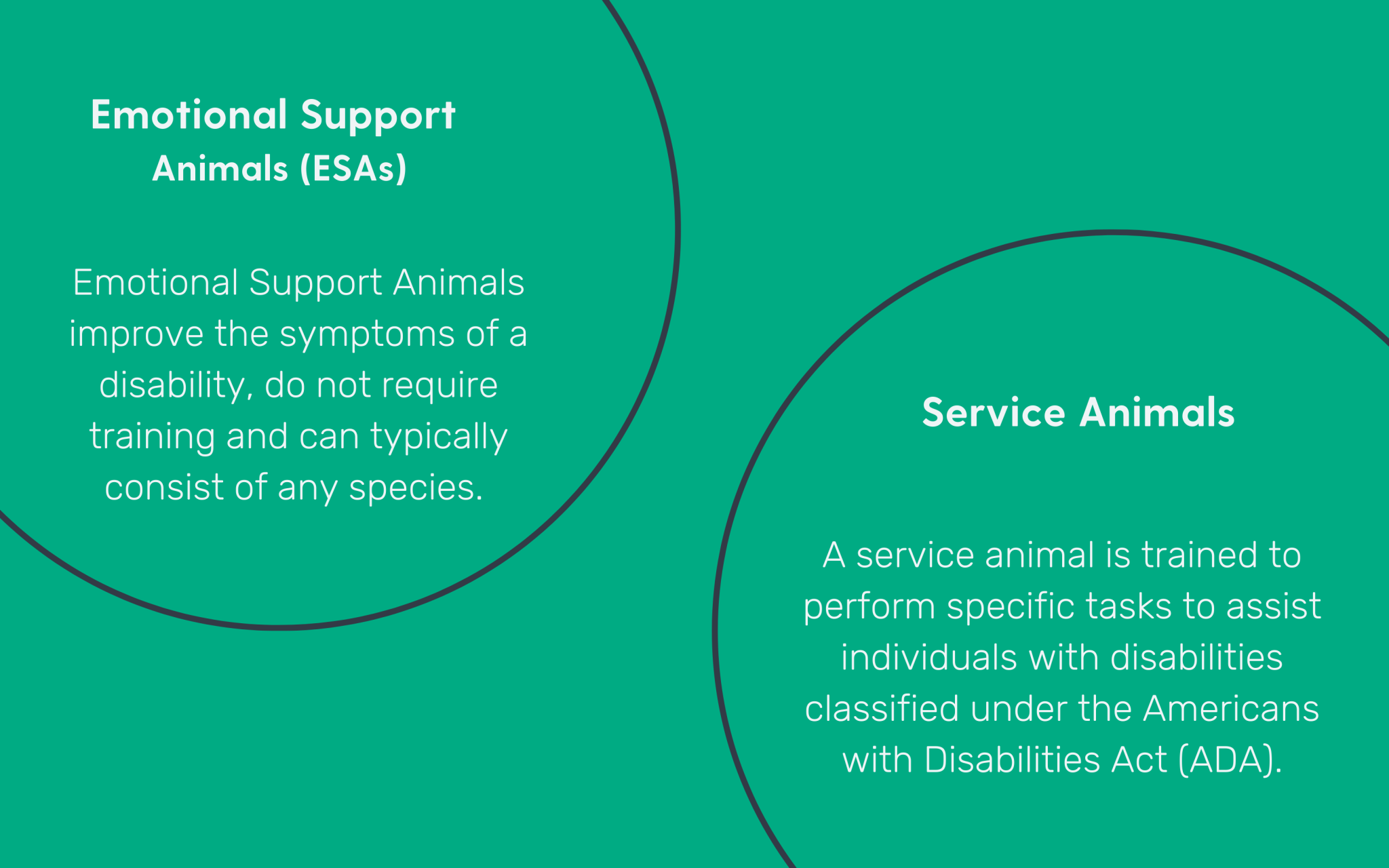If you’re leasing with an emotional support animal (ESA) or service animal, no matter what state you lease an apartment in, there are federal guidelines apartment property groups are called to uphold to ensure equal opportunity to all renters. In this blog, we take you through the classifications of apartment pets, including ESAs and service animals, and what to expect from the leasing process.
The difference between Service and Assistance Animals
It’s common for people to use ESA as an all-encompassing term for animals who support the emotional and physical needs of their owners. But there’s actually a difference between service and assistance animals! Emotional Support Animals improve the symptoms of a disability, do not require training, and can typically consist of any species – think more domestic animals such as cats, dogs, rabbits. A service animal is trained to perform specific tasks to assist individuals with disabilities classified under the Americans with Disabilities Act (ADA).
There are a few main differences between ESAs and service animals. ESAs, also referred to as comfort or therapy animals, do not require formal training in order to provide assistance to their owners and can be a variety of qualified species. Service animals, however, require specific training to perform a service to their owners and can only be designated to dogs and miniature horses (we were just as surprised as you). So, though both classifications of animals help improve the quality of life of their owners, there’s a slight variation in qualifications. Nevertheless, a renter with an ESA or service animal looking to enter into a lease agreement with an apartment property will be asked to show proper medical documentation explaining the need for the animal.
The Fair Housing Act when it comes to animal support and assistance
Under the Fair Housing Act, property owners are required to make “reasonable accommodation” for tenants who have ESAs and service animals. Since there’s a medical necessity for the animal, an ESA or service animal is considered part of a tenant’s wellbeing as opposed to the general classification of a “pet.” Because of this, properties are required to waive pet fees and monthly pet rent, lift breed restrictions and weight limits or allow pets in general for eligible applicants.
Something that’s important to know is that “reasonable accommodation” by landlords and property owners does not relinquish leaseholders with ESAs and service animals from repercussions of damages caused by the pets. Landlords and property owners do have the ability to seek money if the pet has caused damage to the apartment (always make sure you take photos of your apartment before you move all your things in, like every knick or hole). And, if for some reason an ESA causes any major disruptions for other tenants or the physical property, landlords and property owners do have the right to try and remove the assistance animal by way of legal actions and proceedings. Main point: if you’re entering into an apartment lease with an ESA or service animal, make sure they’re as well-trained as possible.

3 important things to note if a renter has a service or assistance animal
There are a few important things we want to touch on before ending this blog. One is that apartment properties will require written permission from a licensed medical professional for the ESA or service animal. If a property feels that a prospective tenant provided a counterfeit doctor’s note, they do have the right to consult with their legal counsel.
The second important thing to note is that even though fees and rent are waived for ESAs and service animals, their breed and weight information is still listed on the formal lease agreement. This doesn’t have ramifications one way or another, but it’s just good to know since a lease is a legally binding contract with the property.
The third and final important note is to make sure to ask about the pet limit per “household.” If you’re entering a lease with an ESA/service animal, but have other pets that don’t have special classifications, it’s just good to make sure you’ve got all your ducks in a row so you don’t end up with any surprises. Most properties allow a limit of 2 general pets per household (not per lease signer), so if there’s ever a situation where that might become an issue, simply talk with a leasing agent at the property you’re looking to lease with. They’ll serve as the best advisors in that situation.
If the content of this blog will be useful to someone you know, feel free to send them the link! Even though our apartment locators service renters moving in or to Texas, Georgia, and Colorado, these guidelines should be upheld nationwide, so the information is relevant anywhere in the United States. Here are a few other links we thought might be helpful in regards to apartment renters with ESAs and service animals:
-The U.S. Department of Housing and Urban Development (HUD) – Re: Assistance animals
-The Humane Society of The United States – Re: The Fair Housing Act and Assistance Animals
-The Americans with Disabilities Act (ADA) – Re: Service animals & Emotional Support Animals









